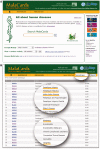MalaCards: an integrated compendium for diseases and their annotation
- PMID: 23584832
- PMCID: PMC3625956
- DOI: 10.1093/database/bat018
MalaCards: an integrated compendium for diseases and their annotation
Abstract
Comprehensive disease classification, integration and annotation are crucial for biomedical discovery. At present, disease compilation is incomplete, heterogeneous and often lacking systematic inquiry mechanisms. We introduce MalaCards, an integrated database of human maladies and their annotations, modeled on the architecture and strategy of the GeneCards database of human genes. MalaCards mines and merges 44 data sources to generate a computerized card for each of 16 919 human diseases. Each MalaCard contains disease-specific prioritized annotations, as well as inter-disease connections, empowered by the GeneCards relational database, its searches and GeneDecks set analyses. First, we generate a disease list from 15 ranked sources, using disease-name unification heuristics. Next, we use four schemes to populate MalaCards sections: (i) directly interrogating disease resources, to establish integrated disease names, synonyms, summaries, drugs/therapeutics, clinical features, genetic tests and anatomical context; (ii) searching GeneCards for related publications, and for associated genes with corresponding relevance scores; (iii) analyzing disease-associated gene sets in GeneDecks to yield affiliated pathways, phenotypes, compounds and GO terms, sorted by a composite relevance score and presented with GeneCards links; and (iv) searching within MalaCards itself, e.g. for additional related diseases and anatomical context. The latter forms the basis for the construction of a disease network, based on shared MalaCards annotations, embodying associations based on etiology, clinical features and clinical conditions. This broadly disposed network has a power-law degree distribution, suggesting that this might be an inherent property of such networks. Work in progress includes hierarchical malady classification, ontological mapping and disease set analyses, striving to make MalaCards an even more effective tool for biomedical research. Database URL: http://www.malacards.org/
Figures






References
-
- Hirschhorn JN, Daly MJ. Genome-wide association studies for common diseases and complex traits. Nat. Rev. Genet. 2005;6:95–108. - PubMed
-
- Baxevanis AD. Searching Online Mendelian Inheritance in Man (OMIM) for information on genetic loci involved in human disease. Curr. Protoc. Hum. Genet. 2012 Chapter 9: Unit 9 13 1–10. - PubMed
-
- Amberger J, Bocchini C, Hamosh A. A new face and new challenges for Online Mendelian Inheritance in Man (OMIM®) Hum. Mutat. 2011;32:564–567. - PubMed
Publication types
MeSH terms
LinkOut - more resources
Full Text Sources
Other Literature Sources

